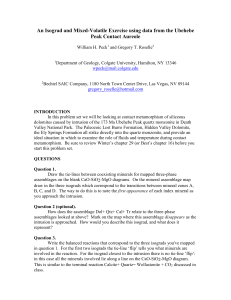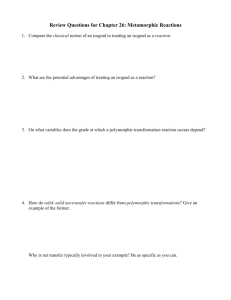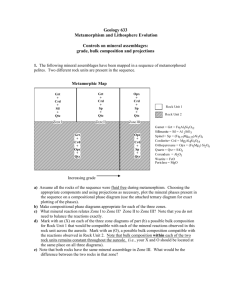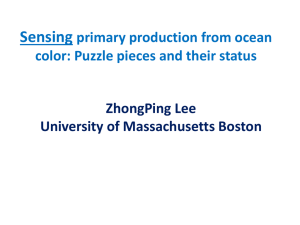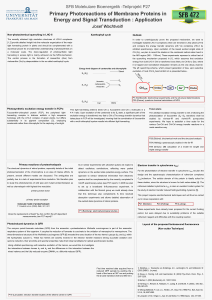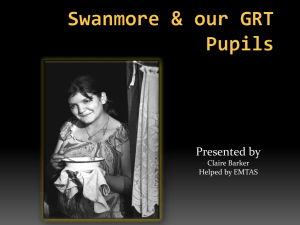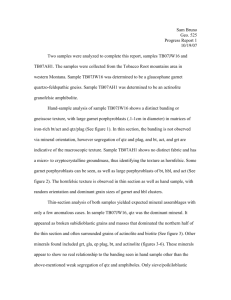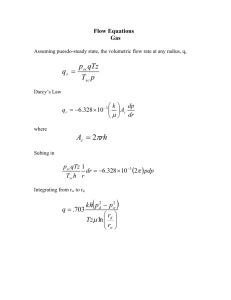Chapter 28
advertisement
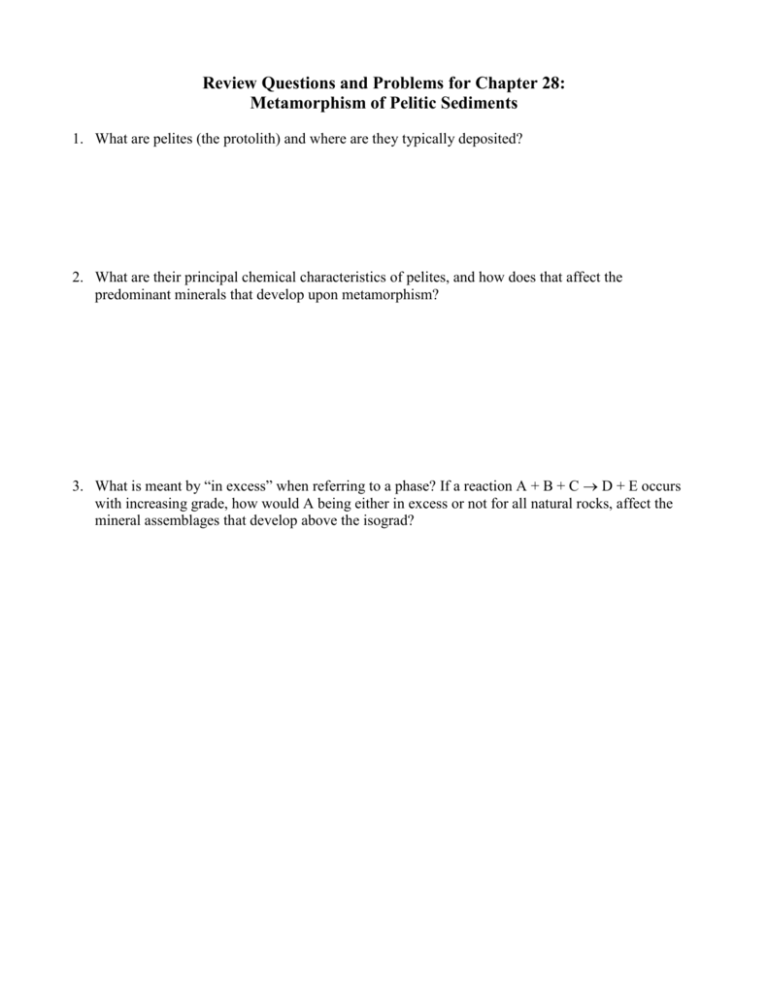
Review Questions and Problems for Chapter 28: Metamorphism of Pelitic Sediments 1. What are pelites (the protolith) and where are they typically deposited? 2. What are their principal chemical characteristics of pelites, and how does that affect the predominant minerals that develop upon metamorphism? 3. What is meant by “in excess” when referring to a phase? If a reaction A + B + C D + E occurs with increasing grade, how would A being either in excess or not for all natural rocks, affect the mineral assemblages that develop above the isograd? 4. Using the fictitious phases A, B, C, and D, propose a reaction that (a) represents the absolute stability limit of phase A. Next propose a reaction (b) that involves all four phases but does not absolutely limit the stability of any. Illustrate the topology changes of both reactions using an imaginary triangular compatibility diagram within which these phases plot. Show the topology both above and below the reaction conditions. Describe which phases appear and/or disappear at the reaction isograds for various bulk compositions within your diagrams. 5. Use the phase rule to determine the variance of Reaction (28.17). St (+Ms Qtz) = Grt Bt Als + H2O (28.17) Why is it considered discontinuous? Why is it considered “terminal” for staurolite? How does the geometry of the chemographic topology change differ from most non-terminal reactions? Under what (equilibrium) circumstances would staurolite be stable above this isograd? Why is Reaction 28.17 generally considered the common St-out isograd? 6. Can you tell whether garnet or chlorite will be consumed first at point 7 in Figure 28.2? Why or why not? 7. Use Figure 28.12 to address the following questions: Over what range of Mg# will garnet never form due to any reaction depicted? Explain. Over what range of Mg# will staurolite never form due to any reaction depicted? Explain. Over what range of Mg# will Reaction (28.12) consume chlorite before garnet? Explain. Over what range of Mg# will Reaction (28.12) consume garnet before chlorite? Explain. Over what range of Mg# will Reaction (28.12) never occur (but staurolite can be generated anyway)? Explain. 8. Pick a steep P/T path on Figure 28.14 and describe the reactions responsible for the transition from the Chl to the Chl + Cld to the Chl + Cld + Grt fields. Determine the variance of each reaction, using the reduced three-component AFM system. Show how each reaction causes the mineral change by sketching an appropriate portion of an AFM diagram both before and after the change occurs. Show your fixed Xbulk and indicate any continuous reactions by arrows showing the motions of migrating fields or field boundaries. 9. Complete Review Question 7 for the transition from the Chl + Grt to the Chl + Grt + Bt to the Ky + Grt + Bt fields in Figure 28.14. 10. Sketch on Figure 28.14 a P-T-t path that most closely corresponds to the classical Barrovian sequence of isograds. Is there a broad range of choices? If not, why do you suppose the sequence is so common? 11. In Section 21.6.4 we looked at development of contact metamorphic minerals in the Skiddaw aureole. Andalusite and cordierite formed at nearly the same metamorphic grade there. How would contact metamorphism for the pelite modeled in Figure 28.14 along a low P/T traverse compare? Would either mineral form appreciably earlier than the other? IF so, which one? 12. Describe the mineral changes that occur with increasing grade in the Xbulk corresponding to the white dot in Figures 28.19a and b. Infer the reaction(s) and sub-triangle migrations (continuous reaction) or tie-line reorganizations (discontinuous reactions) responsible. 13. Describe the mineral changes that occur with increasing grade in the Xbulk corresponding to the white dot in Figures 28.19c and d. Infer the reaction(s) and sub-triangle migrations (continuous reaction) or tie-line reorganizations (discontinuous reactions) responsible. 14. From a geometric standpoint Use Figures 28.14 and 28.19 to propose how Xbulk might be responsible for the difference in sequence between the andalusite-in and cordierite-in isograds. In what way are the Skiddaw rocks most likely to differ from the rock in Figure 28.14? 15. How does leucosome differ from melanosome? Where have we seen similar terms before? What did they mean? 16. In what three principal ways might leucosomes form? 17. Describe the debate over the origin of migmatites. How was it “resolved”? Problems 1. Using Frank Spear’s program GIBBS (see Section 27.5 for the download site), load the Spear and Cheney (S&G) grid and plot it. Choose your own P/T metamorphic field gradient (perhaps between the medium and low P/T gradients in Figure 28.2) and create a series of AFM diagrams along the gradient. Describe the changes in mineral assemblage that occur for a point on the diagram representing analysis 1 in Table 28.1 (North American shale composite). Remember that mineralogical changes can occur as a result of either discontinuous or continuous reactions. 2. Consider the two following reactions: Ms + Qtz St = Bt + Al2SiO5 + H2O Ms + Qtz = Kfs Al2SiO5 + H2O (1) (2) a. Which occurs at the higher temperature? Why? Note: This can be determined from basic principles, and need not reflect the specific nature of any of the minerals involved in the reactions. b. Remembering the common shape of dehydration reactions, sketch both reaction curves on a PT phase diagram (qualitatively, you need assign no values to P and T). In three different field areas, the following occurs with these reactions: Field area A: Reaction (1) produces andalusite, whereas Reaction (2) produces sillimanite. Field area B: Reaction (1) produces kyanite, whereas Reaction (2) produces sillimanite. Field area C: Both reactions produce andalusite. Field area D: Both reactions produce sillimanite. c. Experiment around with the two reactions and the Al2SiO5 phase diagram by trial and error until you can explain the four sequences. Sketch the final phase diagram and list the four field areas in order of P/T metamorphic field gradients. 3. Sketch appropriate AFM diagrams below and above the kyanite-in isograd: St + Chl (+Ms Qtz) = Ky Bt ( +H2O) Reaction (28.15). Balance the reaction for ideal Fe end-members. Discuss which minerals are really lost and gained for rocks in each of the four quadrants of the Ky-St-Bt-Chl quadrilateral. In what types of rocks will all four phases coexist stably above the isograd? What rocks are unaffected by Reaction (28.15), and why? Why is this called the kyanite-in isograd? Label a rock in your above-theisograd drawing that did not develop kyanite by Reaction (28.15) but does develop it by Reaction (28.16) and explain why. 4. Play the animated AFM diagram (for 3 kb: AFM3.MOV), available from your instructor or the documentation page from Roger Powell’s THERMOCALC web site www.earthsci.unimelb.edu.au/tpg/thermocalc/ a few times using your QuickTime player. What reaction is responsible for the introduction of cordierite into most rocks? How did you determine this? Next play AFM6.MOV (6 kb). Why doesn’t cordierite occur in this animation? Place a small dot on your computer screen with an erasable (!) marker in an area affected by chloritoid and describe the sequence of mineralogical changes that affect it. What reaction introduced Cld into your rock? What reaction removed it? 5. Using your laboratory computer and a sample input from your instructor (or download one from my web site, www.prenhall.com/winter/ run Jamie Connolly’s Perple_X program to generate a pseudosection for a specific Xbulk equivalent to my original input, but with Mg#60. To do so, you will have to run VERTEX and supply the name of the input (.dat) file you have used (copied and modified) and then run PSVDRAW, giving it the name of the plot file named in the .dat file. You can then review your graphical results (in a Postscript file) in Adobe Illustrator. How has your new P-T pseudosection differed from Figure 28.14? How prevalent are true univariant reactions? How does the relative development of andalusite versus cordierite differ at low P/T (Review Question 8). You may elect to try pseudosections at other compositions as well. Among many possible lessons from this exercise is the “garbage-in/garbage-out” lesson of computer packages. Most require careful study of the documentation and several trials before getting reasonable results. For example, the input file I have available specifies aqueous fluid and SiO2 saturation (quartz in excess, so you don’t have to specify an amount of SiO2), but care was given to the amounts of Al2O3, K2O, FeO, and MgO in order to meet the Ms-excess requirement as well. Injudicious variations of these input parameters may invalidate this assumption, leading to erroneous results.
